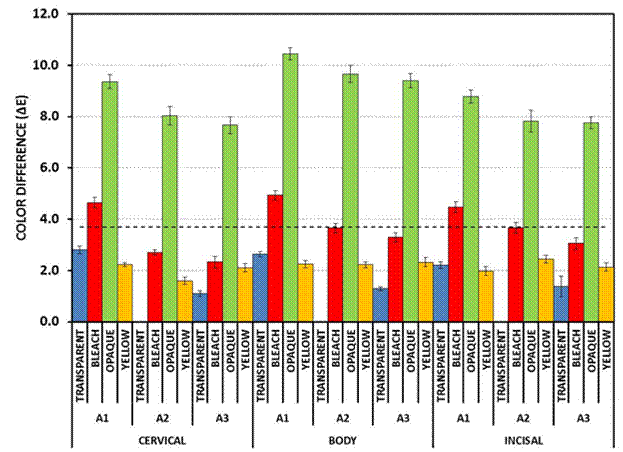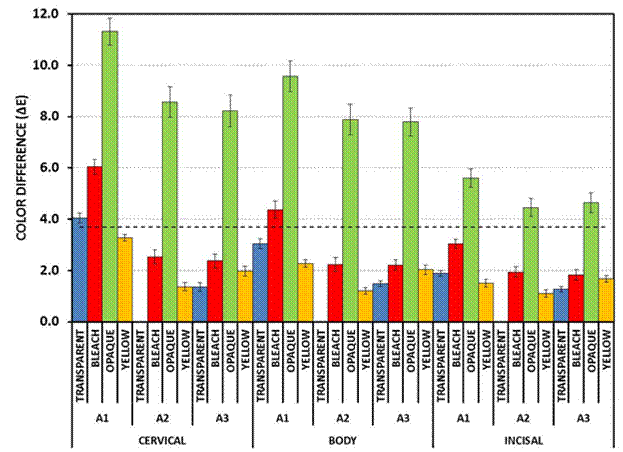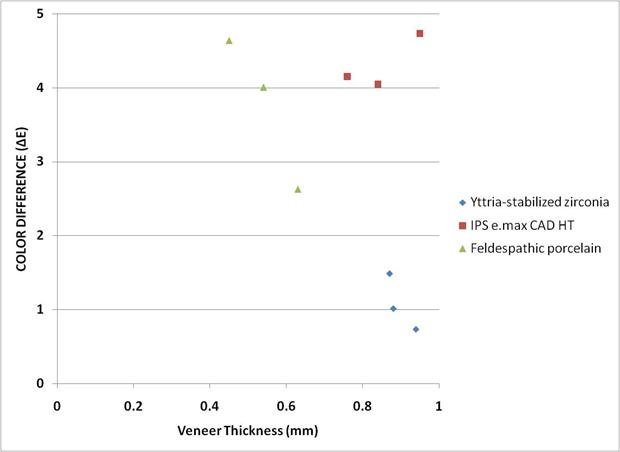Objectives: To investigate the effects of try-in paste (TP) color, composite resin abutment (CRA) color, and ceramic thickness on color changes of feldspathic porcelain (FP), yttria-stabilized zirconia (Y-TZP) and IPS e.max CAD (IEC) laminate veneers. Methods: A melamine tooth was prepared for laminate veneering. A master die was fabricated from a tooth impression which was scanned and designed using TurboDent system. Ten CRA of each color (A1, A2, A3) were machined from resin blocks. Ten veneers were fabricated for each veneer material. The thicknesses were measured at each specific region (cervical, body, incisal). Color coordinates were determined at each region with different colors of CRA and TP (transparent, bleach XL, opaque, yellow) using a spectrophotometer. A color difference (ΔE) of 3.7 was considered the perceptibility threshold. Results: The data for ΔE of all veneers with different TP, and CRA colors at each region are shown in Figure 1(a,b,c). FP and IEC veneers were affected by TP colors, but the later showed higher ΔE for cervical and body regions. There was no effect of CRA color on ΔE except at the cervical region for FP veneers (ΔE>3.7). The veneer thickness was correlated to ΔE for combinations of different TP and CRA colors (Figure 2). All regions of Y-TZP veneers and incisal region of FP veneers did not show color changes (ΔE<3.7). Conclusions: IPS e.max CAD veneers were more sensitive to try-in paste color changes compared with feldspathic porcelain veneers. All regions of different veneer thicknesses were affected by color changes (ΔE >3.7) for IPS e.max CAD while only the body and cervical regions were affected for feldspathic porcelain veneers. There was no effect of thickness, try-in paste and composite resin abutment colors on ΔE of yttria-stabilized zirconia veneers.
Figure 1: (a) Yttria stabilized zirconia veneers. (b) IPS e.max CAD veneers. (c) Feldspathic porcelain veneers. The color change (ΔE) at the three veneer regions with different composite resin abutments and try in paste colors compared to the control color (composite resin abutment color (A2) and glycerin). The ΔE is illustrated by a horizontal dotted line at 3.7. |
|

|

Figure 2: The effect of laminate veneer thickness from cervical region to incisal region on the color difference for yttria stabilized zirconia, IPS e. max CAD, and feldspathic porcelain materials. |
Keywords: CAD/CAM, Ceramics, Color and Esthetics
![[ Visit AADR's Website ]](images/banner.jpg)

